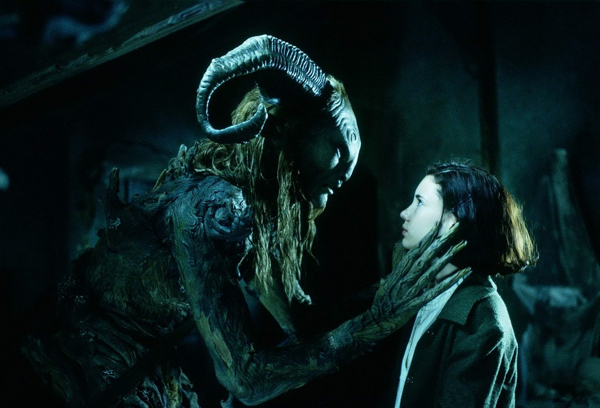Movie review by Greg Carlson
Critics have lined up to sing the praises of Guillermo del Toro’s latest movie “Pan’s Labyrinth,” a well made fantasy set during the aftermath of the Spanish Civil War. Juggling outré surrealism with equally ghoulish reality, del Toro returns to some of the same territory he covered in “The Devil’s Backbone,” a movie just as good as “Pan’s Labyrinth.” Following the tale of Ofelia (Ivana Baquero), a young girl whose stepfather is a cruel military officer, “Pan’s Labyrinth” will delight fans of the filmmaker’s fantastic imagination. Far from a masterpiece, however, the movie tempers one’s enthusiasm with several lost opportunities, including a better handling of the heroine’s relationship with some of the supernatural creatures she encounters.
Following exposition that introduces Ofelia and her very sick, very pregnant mother, del Toro dissects the movie into two related spheres: the hallucinatory otherworld that Ofelia visits in order to receive instructions from the half-man, half-goat faun of the title, and the nightmarish compound where Ofelia’s violent stepfather Vidal (Sergi Lopez) oversees an operation to stop a group of rebel fighters in the surrounding woods. Toggling back and forth between the two storylines, del Toro might have taken more steps to integrate them, but taken individually, scenes regularly crackle with suspense and intrigue.
Like many fairy tales, Ofelia is given a set of three tasks she must accomplish in order to restore her crumbling world. In one sequence, she descends into the root system of a gnarled tree to face a bloated, phlegmatic toad. In another, she encounters the nightmarish Pale Man (Doug Jones, who also plays Pan), a beautifully realized bogeyman who keeps his eyeballs in the palms of his hands. All of the creature design is impeccable, but some viewers might become impatient with a pronounced lack of clarity in the rules and regulations of the fantasy realm, and exactly how Ofelia’s assignments are tied to a particular outcome.
In terms of narrative coherence, del Toro does a great deal better when he is dealing with Mercedes (Maribel Verdu), Vidal’s housekeeper and a secret ally and conspirator with the guerillas. As Mercedes develops into a surrogate mother for Ofelia, she finds herself in constant danger of being discovered by her sadistic employer, and Verdu brings a perfect blend of defiance, determination, and fear to her role. The inevitable showdown between Mercedes and Vidal is a heart pounding showstopper of a scene that will have the more squeamish viewers burying their faces in their hands.
By the time “Pan’s Labyrinth” marches to its potent, emotionally charged conclusion, del Toro has slowly but surely engrossed his viewers, and the film has a mostly satisfying resonance. Some will likely read Ofelia’s encounters with the fantasy world merely as her means of dealing with the unfathomable conditions of her situation, while others will identify an allegorical treatment of wartime cruelties. Yet another option simply believes in fairies, fauns, and other magical brutes. Del Toro doesn’t require us to choose, which makes “Pan’s Labyrinth” very much a movie worth seeing.
